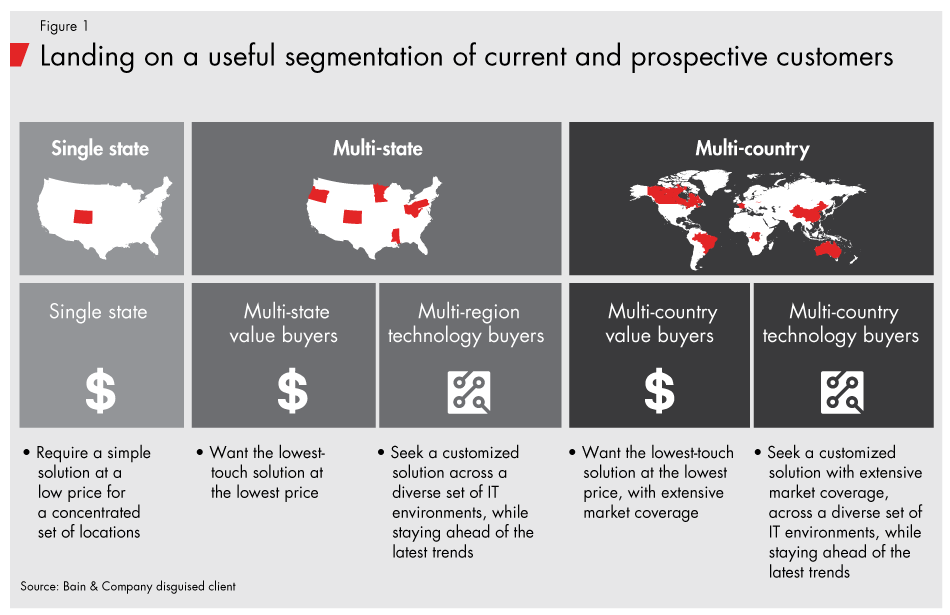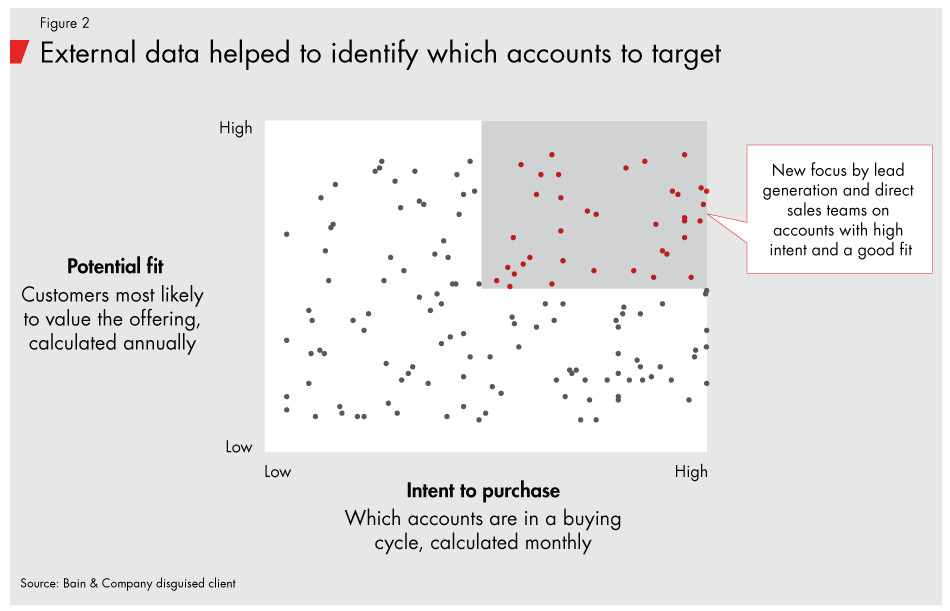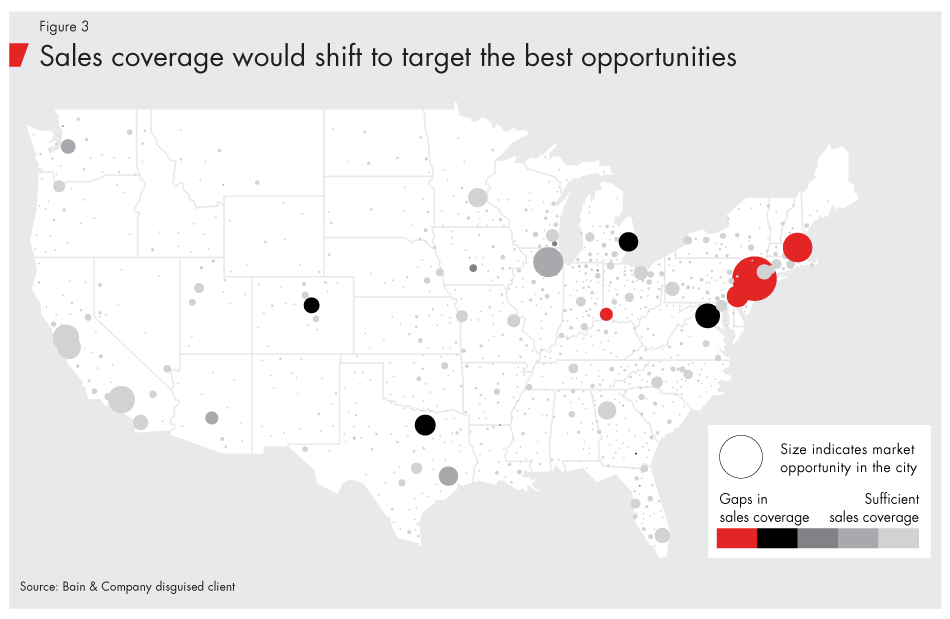Brief

Imagine you work for a company that provides technology to businesses and has the following go-to-market approach. You crunch external financial, demographic and technology data to determine the probability of any company fitting in the segments most likely to buy more of your solutions. You use external intent indicators, such as search terms and job postings, to understand whether these businesses have appetite to buy a solution right now. Without making a phone call, you have filtered every potential customer to identify those in your sweet spot looking to buy, by city. You then deliver digital advertising to the individuals who made those searches, tailoring the content to their segment. Your inside sales team calls them to offer the latest white paper on the topic they were searching for, and perhaps to set up a first meeting. Only then do you send a sales representative, who already knows their segment and the trends that interest them, and how your value proposition will appeal to them.
A few leading companies have, in fact, been taking just such a focused approach that stitches together the right data with customized marketing and sales analytics tools, to reach the right buyers with the right offering at the right place and time.
It’s a far cry from the way many business-to-business (B2B) companies allocate sales resources: through rules of thumb. Too often, senior executives spread sales targets like jam evenly across accounts. Likewise, quotas are based on last year’s results plus a percentage, rather than taking a quantified, full-wallet view of what accounts each sales rep should pursue.
Few companies take the trouble each year to zero-base their market opportunities, account by account, including new accounts and those where the company has the opportunity to increase share of wallet. Without this discipline, sales executives are flying blind as they plan their route-to-market approach, set sales capacity in each region and assign reps to cover specific opportunities. They don’t know where to invest or how to win—namely, exactly which accounts have potential upside, or exactly how to mobilize to win high-value new accounts. An extra 5% of resources spread evenly or allocated without a precise understanding of where market opportunities reside might be wasted, with millions of dollars in potential incremental revenue overlooked.
Kate Woolley, a partner with Bain's Customer Strategy & Marketing practice, shares how leading companies use a rigorous zero-based approach at the account level to get a clear view of revenue potential in the market.
New technologies make such analysis even more compelling. Big data analytics allow B2B companies to develop smarter segmentations based on customers’ needs, behaviors and firmographics. And analytical tools help sales leaders put their segmentations into operation by identifying target accounts and allocating marketing and sales efforts in real time.
Doing a thorough up-front market opportunity analysis proved to be a revelation for one IT services provider. After several years of strong growth in revenues, the company’s growth had begun to stall, and the firm’s senior team decided to draw up a blueprint for the next phase of growth.
Predicting a great match
The company started by surveying more than 500 decision makers about their priorities and spending in the various service categories, as well as 400 resellers and other channel partners. It combined survey results with third-party data on spending, the location of customers’ operations, the size and composition of their IT staff, patent filings and the technology environment in each customer. All this data informed a segmentation of 160,000 companies in the US along two dimensions: the geographic reach of the account’s or prospect’s operations, and whether they were technology-driven companies or ones that viewed IT services as a commodity requiring a low-touch solution at a low price (see Figure 1).
With these broad segments, the company used predictive analytics software to define the revenue opportunity for each account and prospect (see Figure 2). For example, the company used Lattice Engines, which crunches data such as signs of new technology adoption or a social media presence, to predict who would be ready to buy based on similarities to the company’s current high-value customers. Another tool, DiscoverOrg, offers organizational information that might indicate intent to purchase, such as job postings for a vice president of network.


This exercise widened the aperture for potential revenue. Previously, sales executives had defined their sweet spot as accounts with a global reach and a track record of strong innovation. The new segmentation showed that accounts with a regional reach, and even some accounts that emphasized value buying, also had high potential.
The company also learned that a surprisingly large number of high-potential accounts were considering adoption of a particular new technology.
For its best prospects, the IT services company turned to content syndication services, placing articles and white papers about a specific industry or topic. Marketers tracked who read or downloaded the content. The company also used a content repository and a marketing delivery tool, which linked to the customer relationship management (CRM) system. Marketers delivered targeted email messages and digital ads to customers in specific segments and stages of the buying cycle. For example, a price-conscious retailer interested in the new technology might get advertising that emphasizes the company’s strength in that technology, the ease of getting started and the great customer experience. A leading-edge start-up with a new CEO might get a white paper on the evolution of this segment of IT services, including a case study of a similar start-up.
Based on the more detailed picture of market opportunities, the IT services company then redesigned its sales coverage. Previously, having relied primarily on value-added resellers and other local distributors, the company employed a very small direct salesforce. After sales executives learned that 60% of customers preferred a direct model, they set out to build a much larger direct force. Territory design also had to change to one that raised investment in East Coast resources (see Figure 3).

Devoting fewer resources to noncore services and locations freed up resources to focus on the newly defined high-potential accounts and prospects. Better targeting led to double the conversion rates in the early part of the sales funnel. This has the company on track to double bookings by 2020. As this company discovered, taking a rigorous approach to uncovering the high-value opportunities, at a detailed account level, gives sales leaders a clear view to their most promising markets.
Mark Kovac is a partner, Jonathan Hanson is a principal, and Jonny Holliday and Jeff Taylor are partners in Bain & Company’s Customer Strategy and Marketing practice. They are based, respectively, in Dallas, Dallas, New York and Boston.


